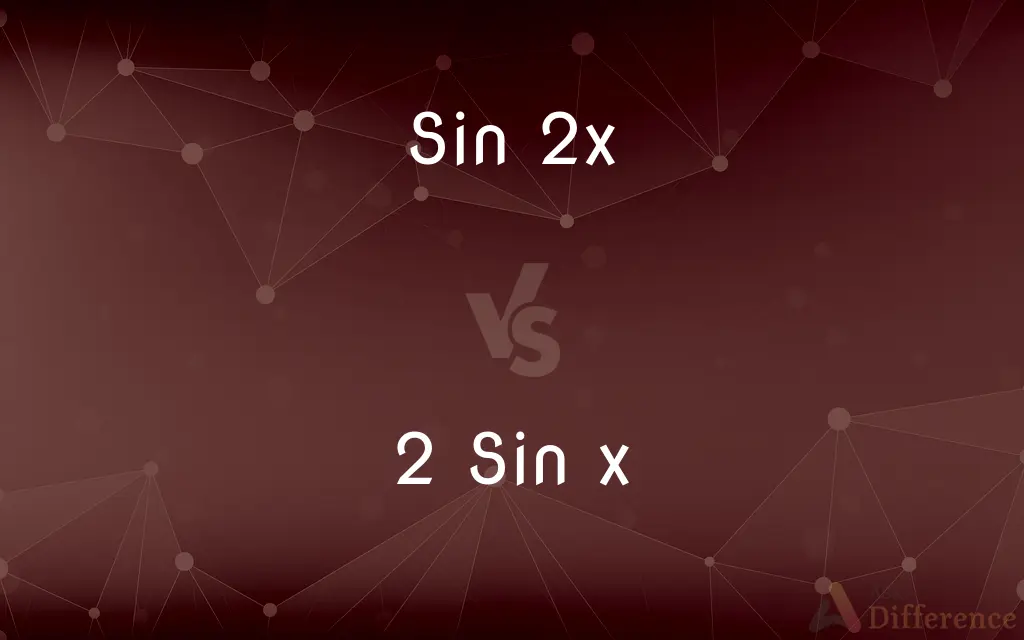Sin 2x vs. 2 Sin x — What's the Difference?
By Tayyaba Rehman & Urooj Arif — Published on February 1, 2024
Sin 2x refers to the sine of twice the angle x, a specific trigonometric function, whereas 2 Sin x is twice the sine of angle x, a scaled version of the sine function.

Difference Between Sin 2x and 2 Sin x
Table of Contents
ADVERTISEMENT
Key Differences
Sin 2x represents the sine function of a doubled angle, crucial in trigonometric identities. In contrast, 2 Sin x is the multiplication of the sine of a single angle x by 2, effectively scaling the function's amplitude.
In Sin 2x, the angle x is doubled before applying the sine function, altering the function's period and waveform. 2 Sin x, however, retains the original period of the sine function, merely doubling its values.
The graph of Sin 2x shows a sine wave with a halved period compared to the standard sine wave, indicating a faster oscillation. The graph of 2 Sin x shows a sine wave with the same period as Sin x, but with double the height.
In applications, Sin 2x is used in formulas involving angular relationships, like in physics for wave equations. 2 Sin x, however, is often used in situations requiring amplitude adjustments, such as in sound waves or alternating currents.
From a mathematical perspective, Sin 2x is an example of angle transformation in trigonometry, while 2 Sin x demonstrates amplitude transformation, both essential concepts in advanced mathematics.
ADVERTISEMENT
Comparison Chart
Definition
Sine of double the angle (sine of 2 times x)
Double the sine of the angle (2 times sine x)
Period of Function
Halved compared to Sin x
Same as Sin x
Amplitude
Same as Sin x
Double that of Sin x
Graphical Appearance
More frequent oscillations than Sin x
Higher peaks and deeper troughs than Sin x
Usage
Used in angle transformations
Used to scale the amplitude of sine wave
Compare with Definitions
Sin 2x
Sin 2x is essential in oscillatory motion equations.
Sin 2x appears in the formula for the harmonic motion of a pendulum.
2 Sin x
2 Sin x scales the sine function vertically.
The function 2 Sin x doubles the height of all points on the sine curve.
Sin 2x
Sin 2x alters the period of the sine wave.
The graph of Sin 2x shows a wave that completes its cycle in half the time of Sin x.
2 Sin x
2 Sin x is the sine of x multiplied by 2.
In wave analysis, 2 Sin x represents a wave with twice the normal amplitude.
Sin 2x
Sin 2x is a function of a doubled angle.
For a given angle x, Sin 2x calculates the sine of 2x.
2 Sin x
2 Sin x maintains the original sine wave period.
The graph of 2 Sin x oscillates with the same frequency as Sin x but with greater amplitude.
Sin 2x
Sin 2x is the sine of twice an angle.
In trigonometry, Sin 2x is used to simplify expressions involving double angles.
2 Sin x
2 Sin x is used to adjust wave amplitude.
In acoustics, 2 Sin x can model a sound wave with increased volume.
Sin 2x
Sin 2x is used in trigonometric identities.
The identity Sin 2x = 2 Sin x Cos x is fundamental in trigonometry.
2 Sin x
2 Sin x is a simple amplitude modification.
For harmonic oscillations, 2 Sin x can represent a system with increased energy.
Common Curiosities
Does 2 Sin x change the frequency of the sine wave?
No, 2 Sin x does not change the frequency, only the amplitude.
Can Sin 2x be expressed in terms of Sin x and Cos x?
Yes, Sin 2x can be expressed as 2 Sin x Cos x.
Is 2 Sin x a basic trigonometric function?
No, it's a scaled version of the basic sine function.
How does Sin 2x affect the sine wave's period?
Sin 2x halves the period of the sine wave compared to Sin x.
What is the amplitude of the Sin 2x wave?
The amplitude of Sin 2x is the same as that of Sin x.
Is Sin 2x used in calculus?
Yes, Sin 2x is used in calculus, particularly in integration and differentiation involving trigonometric functions.
Is 2 Sin x ever used in engineering?
Yes, engineers use 2 Sin x in designing systems that require amplitude adjustments, like in signal processing.
What is the primary difference between Sin 2x and 2 Sin x?
Sin 2x involves doubling the angle before applying sine, while 2 Sin x involves doubling the result of the sine function.
In what scenarios is Sin 2x commonly used?
Sin 2x is used in physics and mathematics, especially in wave equations and trigonometric identities.
How do Sin 2x and 2 Sin x relate to phase shifts?
Neither function inherently involves a phase shift, but they alter period and amplitude, respectively.
Do Sin 2x and 2 Sin x have the same graph shape?
No, Sin 2x has more frequent oscillations, while 2 Sin x has taller waves.
Are Sin 2x and 2 Sin x used in the same mathematical contexts?
Not always, as they serve different purposes in trigonometry and applied mathematics.
How does 2 Sin x affect sound waves in acoustics?
2 Sin x models sound waves with twice the normal loudness.
Can Sin 2x be used to solve triangles?
Sin 2x is more often used in algebraic manipulations than in direct triangle solutions.
Can 2 Sin x be derived from Sin 2x?
No, they are distinct functions and one cannot be derived directly from the other.
Share Your Discovery

Previous Comparison
Chickenpox vs. Hand Foot and Mouth
Next Comparison
Yu-Gi-Oh! vs. Yu-Gi-Oh! 5D’sAuthor Spotlight
Written by
Tayyaba RehmanTayyaba Rehman is a distinguished writer, currently serving as a primary contributor to askdifference.com. As a researcher in semantics and etymology, Tayyaba's passion for the complexity of languages and their distinctions has found a perfect home on the platform. Tayyaba delves into the intricacies of language, distinguishing between commonly confused words and phrases, thereby providing clarity for readers worldwide.
Co-written by
Urooj ArifUrooj is a skilled content writer at Ask Difference, known for her exceptional ability to simplify complex topics into engaging and informative content. With a passion for research and a flair for clear, concise writing, she consistently delivers articles that resonate with our diverse audience.
















































